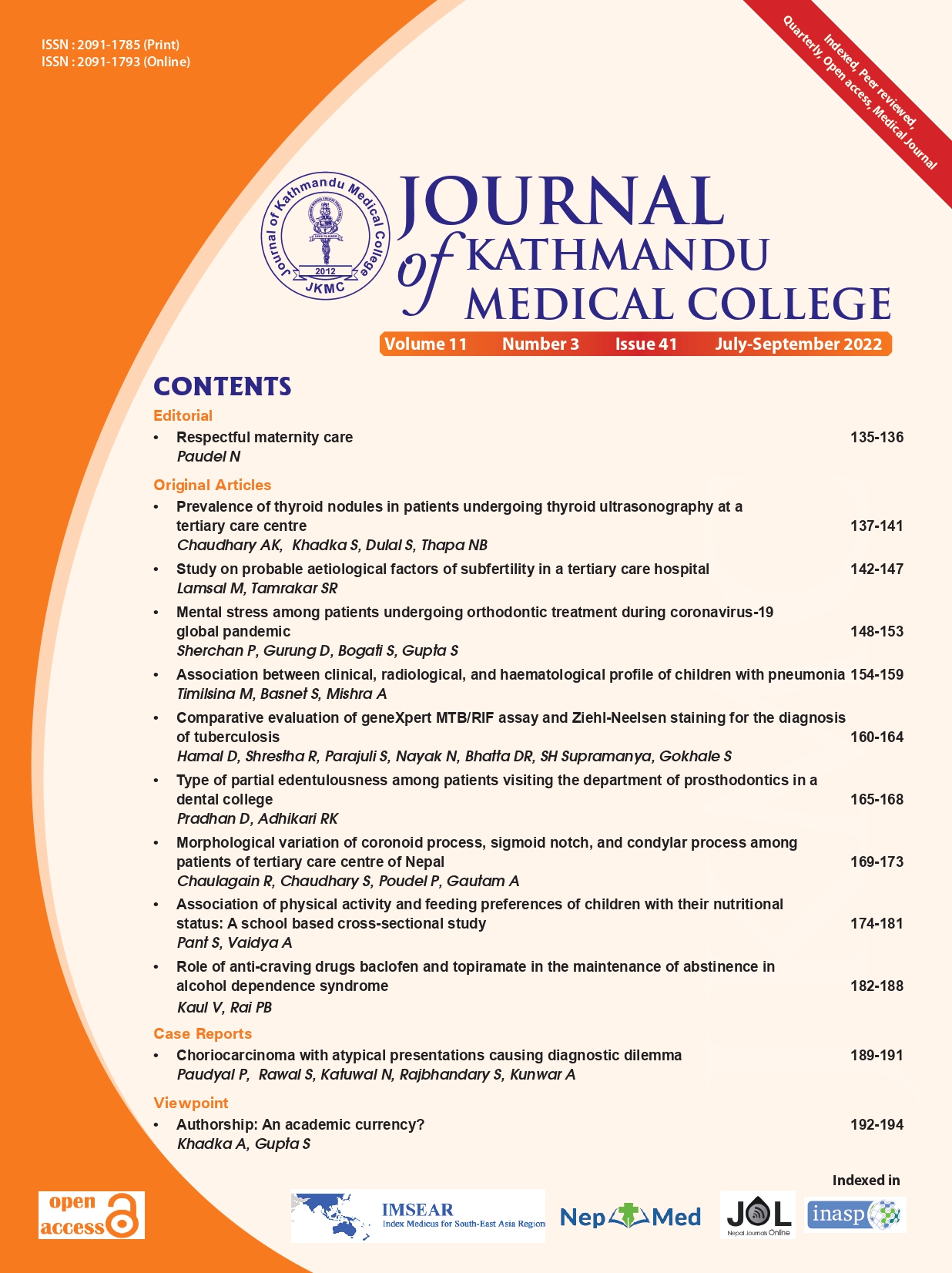Association between clinical, radiological, and hematological profile of children with pneumonia
DOI:
https://doi.org/10.3126/jkmc.v11i3.50786Keywords:
Child, Cough, PneumoniaAbstract
Background: Patients with pneumonia present with varying symptoms, X-ray features and changes in the blood parameters.
Objectives: To find out the association between clinical, radiological, and haematological profile of children with pneumonia.
Methods: An analytical cross-sectional study was conducted in 130 children aged two to 60 months admitted to the paediatric ward of Manipal Teaching Hospital, who were chosen by convenience sampling technique from December 2019 to November 2020, and clinical, radiological and haematological parameters compared. The observed data were analysed using SPSS 20.
Results: . Of the 130 children studied, 80 (61.5%) were male and 50 (38.5%) were female. History of prior admission for respiratory illness was seen in 75 (57.7%) patients Bronchopneumonia was seen in 72 (55.4%) patients and lobar pneumonia in 37 (28.5%) patients. Cough 122 (93.8%), Noisy breathing 86 (66.15%), Fever 70 (53.84%) and Fast breathing 67 (51.54%) were the most common presenting complaints. Patients with lobar pneumonia were more likely to present with fever than those with Bronchopneumonia (p-value 0.015). Those with history of prior admission were more likely to present with wheeze (p-value 0.035) and crepitations (p-value 0.024) than those admitted for the first time. Also, those presenting with crepitations as lung finding, were found to present with significantly lower total White blood cells (WBC) counts (p-value 0.012).
Conclusion: There seems to be a significant association between fever as presenting complaint and lobar pneumonia. Also, those with history of prior admission are more likely to have lung signs (wheeze/crepitations) at presentation.
Downloads
References
Williams BG, Gouws E, Boschi-Pinto C, Bryee J, Dye C. Estimates of worldwide distribution of child deaths from acute respiratory infections. Lancet Infect Dis. 2002;2:25-32. PMID: 11892493
World Health Organisation. Revised WHO classification and treatment of childhood pneumonia at health facilities. Available from https://apps.who.int/iris/bitstream/10665/137319/1/9789241507813_eng.pdf Accessed 12/9/2019
Department of Health Services. Annual Report for Fiscal year 2074/75. Available from https://dohs.gov.np/wp-content/uploads/2019/07/DoHS-Annual-Report-FY-2074-75-date-22-Ashad-2076-for-web-1.pdf Accessed 12/9/2019
Kelly MS, Sandora TJ. Community Acquired Pneumonia. In: Kliegman R, Stanton R, Geme J, Schor N, Behrman R, editors. Nelson Textbook of Pediatrics, 20 ed. Canada: Elsevier; 2015. 2088-93.
Graham NM. The epidemiology of acu¬te respiratory infections in children and adults: a global perspective. Epidemiologic reviews. 1990;12:149-78. DOI: 10.1093/oxfordjournals.epirev.a036050
Guerrant, Richard L, Oriá RB, Moore SR, OB Oriá MO, Lima AAM. Malnutrition as an enteric infectious disease with long-term effects on child development. Nutrition reviews.2008;66(9):487-505. DOI https://doi.org/10.1111/j.1753-4887.2008.00082.x
World Health Organisation. Revised WHO classification and treatment of childhood pneumonia at health facilities. Available from https://apps.who.int/iris/bitstream/10665/137319/1/9789241507813_eng.pdf Accessed 12/9/2019
Prabakar S, Ramanathan R, Lakshmi SY. Clinical profile and outcome of pneumonia in children. JMSCR;4(10):1328-9. DOI: https://dx.doi.org/10.18535/jmscr/v4i10.79
Shekhawat YS, Sharma P, Singh A, Payal V. Bacteriological and clinical profile of community acquired pneumonia in hospitalised children with associated co-morbidity in a tertiary care centre of Western Rajasthan, India. Int J Contemp Pediatr 2016;3:1380-4. DOI: http://dx.doi.org/10.18203/2349-3291.ijcp20163682
Suanny GC, Jose EA, Wilfrido CR, Fernando SM, Nelson AG. Severity factors of Acquired Pneumonia Community in a children’s hospital in the Colombian Caribbean Salud Uninorte. Barranquilla. 2018;34(2):302-14.
Shukla OP, Dave R, Doshi RP. Clinical and microbiological profile of pneumonia in severe acute malnourished children. Int J Res Med Sci. 2017;5(3):1078-83. DOI: http://dx.doi.org/10.18203/2320-6012.ijrms20170665
Nazeer S, Mythili B, Thangavel A, Maheswari. Clinical profile, risk factors and outcome of pneumonia in 60 days to 60 months children in a tertiary care hospital. Stanley Medical Journal.2016;3(4):80-6.
Rudan I. Epidemiology and etiology of childhood pneumonia. Bulletin of the World Health Organization. 2008;86(5):408-16. DOI: 10.2471/BLT.07.048769
Bharti B, Kaur L, Bharti S. Role of chest X-ray in predicting outcome of acute severe pneumonia. Indian Pediatr. 2008;45(11):893–8. PMID: 19029561
Waris R, Nisar YB, Bhatti N. Association of Hematological and radiological findings with clinical outcome in hospitalized children 2-36 months old with severe lower respiratory tract infection. J Ayub Med Coll Abbottabad. 2016;28(2):229-36. PMID: 28718556
Downloads
Published
How to Cite
Issue
Section
License
Copyright (c) 2022 Journal of Kathmandu Medical College

This work is licensed under a Creative Commons Attribution-NonCommercial 4.0 International License.
Copyright © Journal of Kathmandu Medical College
The ideas and opinions expressed by authors or articles summarized, quoted, or published in full text in this journal represent only the opinions of the authors and do not necessarily reflect the official policy of Journal of Kathmandu Medical College or the institute with which the author(s) is/are affiliated, unless so specified.
Authors convey all copyright ownership, including any and all rights incidental thereto, exclusively to JKMC, in the event that such work is published by JKMC. JKMC shall own the work, including 1) copyright; 2) the right to grant permission to republish the article in whole or in part, with or without fee; 3) the right to produce preprints or reprints and translate into languages other than English for sale or free distribution; and 4) the right to republish the work in a collection of articles in any other mechanical or electronic format.




